
Euphorbia is a very large and diverse genus of flowering plants, commonly called spurge, in the spurge family (Euphorbiaceae). "Euphorbia" is sometimes used in ordinary English to collectively refer to all members of Euphorbiaceae, not just to members of the genus. Some euphorbias are commercially widely available, such as poinsettias at Christmas. Some are commonly cultivated as ornamentals, or collected and highly valued for the aesthetic appearance of their unique floral structures, such as the crown of thorns plant. Euphorbias from the deserts of Southern Africa and Madagascar have evolved physical characteristics and forms similar to cacti of North and South America, so they are often incorrectly referred to as cacti. Some are used as ornamentals in landscaping, because of beautiful or striking overall forms, and drought and heat tolerance.

Euphorbia virosa, the Gifboom or poison tree, is a plant of the spurge family Euphorbiaceae. It has a short main stem, usually twisted, from which 5–10 cm branches emerge. These leafless branches have 5 to 8 edges. Paired thorns grow in regularly spaced intervals from the edges.

Euphorbia esula, commonly known as green spurge or leafy spurge, is a species of spurge native to central and southern Europe, and eastward through most of Asia north of the Himalaya to Korea and eastern Siberia.

Euphorbia heterophylla, also known under the common names of (Mexican) fireplant, painted euphorbia, Japanese poinsettia, desert poinsettia, wild poinsettia, fire on the mountain, paintedleaf, painted spurge, milkweed, and kaliko plant, is a plant belonging to the Euphorbiaceae or spurge family.

Euphorbia amygdaloides, the wood spurge, is a species of flowering plant in the family Euphorbiaceae, native to woodland locations in Europe, Turkey and the Caucasus. It is a bushy evergreen perennial, growing to a height of 80 cm (31 in), with dark green slightly hairy leaves about 6 cm (2 in) long. The complex green-yellow inflorescence (cyathium), typical of Euphorbia, appears in late spring and early summer.
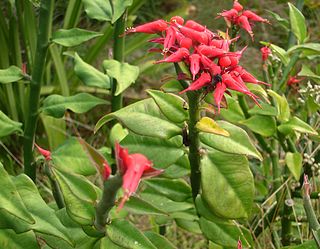
Euphorbia tithymaloides is a perennial succulent spurge. An erect shrub, the plant is also known by the scientific name Pedilanthus tithymaloides. However, the genus Pedilanthus has been submerged into the genus Euphorbia, and is more correctly known by its new name.
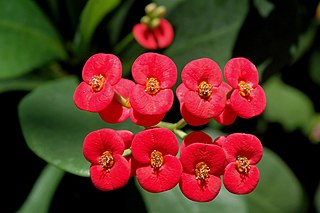
Euphorbia milii, the crown of thorns, Christ plant, or Christ thorn, is a species of flowering plant in the spurge family Euphorbiaciae, native to Madagascar. The species name commemorates Baron Milius, once Governor of Réunion, who introduced the species to France in 1821. It is imagined that the species was introduced to the Middle East in ancient times, and legend associates it with the crown of thorns worn by Christ. It is commonly used as an ornamental houseplant that can be grown in warmer climates. The common name is due to the thorns and deep red bracts referring to the crown thorn Jesus had to wear during his crucification and his blood.
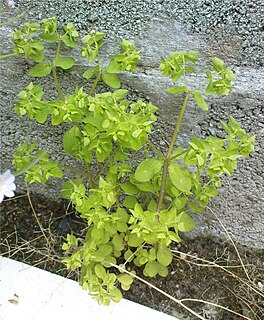
Euphorbia peplus, is a species of Euphorbia, native to most of Europe, northern Africa, and western Asia, where it typically grows in cultivated arable land, gardens, and other disturbed land.
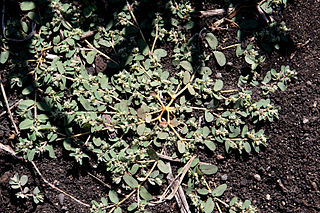
Euphorbia maculata, known as spotted spurge or prostrate spurge, the latter name not to be confused with Euphorbia prostrata, is a fast-growing annual plant in the family Euphorbiaceae, native to North America. It is a common garden and lawn weed in the United States.

Euphorbia paralias, the sea spurge, is a species of Euphorbia, native to Europe, northern Africa, and western Asia.
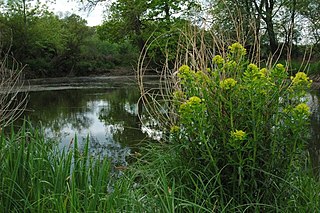
Euphorbia palustris, the marsh spurge or marsh euphorbia, is a species of flowering plant in the family Euphorbiaceae, native to marshland throughout much of mainland Europe and western Asia. It is an herbaceous perennial growing to 90 cm (35 in) tall and wide, with narrow leaves turning red and yellow in autumn, and persistent, bright acid yellow flower-heads (cyathia), 15 cm (6 in) across, in spring.

Euphorbia rigida, the gopher spurge or upright myrtle spurge, is a species of flowering plant in the spurge family Euphorbiaceae, native to southern Europe and southwest Asia. Growing to 50 cm (20 in) tall and broad, it is a bushy evergreen perennial with somewhat fleshy leaves arranged in a spiral, bearing bunches of bright yellow flowers in late Spring.

Euphorbia hirta is a pantropical weed, originating from the tropical regions of the Americas. It is a hairy herb that grows in open grasslands, roadsides and pathways in the warmer regions of India and Australia as an introduced species. It is used in traditional herbal medicine.

Euphorbia mammillaris is a plant species endemic to Cape Province of South Africa. It grows up to 18 cm in height, with succulent stems covered with gray spines.
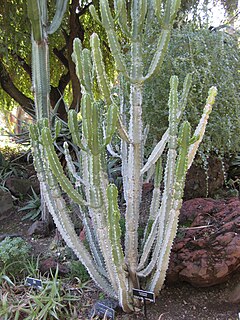
Euphorbia royleana is a species of flowering plant in the family Euphorbiaceae. It is also known as Sullu spurge, and Royle's spurge. It is a succulent and almost cactus like in appearance although unrelated. It grows right across the Himalaya mountains from Pakistan, India, Bhutan, Myanmar, Nepal to western China, It prefers dry and rocky slopes between 1000 and 1500 meters, but has been found up to 2000 meters. Flowering and fruiting is in spring to early summer (March–July) and seeding is in June–October. It is used as a hedging plant in northern India and has medicinal uses.

Euphorbia cornigera is a species of flowering plant in the Euphorbiaceae family. It is referred to by the common name horned spurge and is native to Bhutan. It is a rhizomatous herbaceous perennial growing to 75 cm (30 in) tall, rarely 1 m, with narrow green leaves with a pale green spine. Acid yellow flowerheads (cyathia) are borne in summer.

Euphorbia clavarioides is a species of herbaceous plant in the family Euphorbiaceae. It is native to Botswana, Lesotho, and South Africa. It may grow to 18 cm in diameter, with a height of 30 cm. Its flowers are yellow.
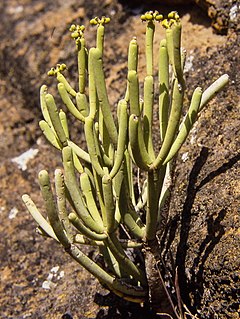
Euphorbia aphylla is a species of flowering plant in the family Euphorbiaceae. It is native to the Canary Islands. It was first described in 1809.

Euphorbia × martini, or Martin’s spurge, is a hybrid between two species of flowering plant, E. amygdaloides × E. characias subsp. characias in the spurge family Euphorbiaceae. It was found growing wild in southern France. Growing to 60 cm (24 in) tall and broad, it is a dwarf evergreen subshrub with narrow grey-green leaves and in late spring and early summer, sprays of lime green flowers, often with a red or maroon eye. It is useful as a spreading, weed-smothering groundcover. Though hardy down to −15 °C (5 °F), it is a Mediterranean plant best grown in a sheltered spot in well-drained soil in full sun.
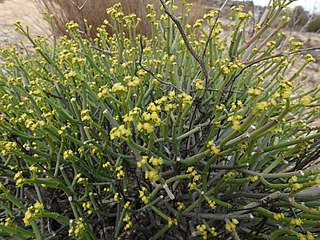
Euphorbia rhombifolia is a species of flowering plant in the Euphorbiaceae family. It is native to Namibia and South Africa, where it is widespread in clay-rich soils, extending as far east as Kwazulu-Natal.



















